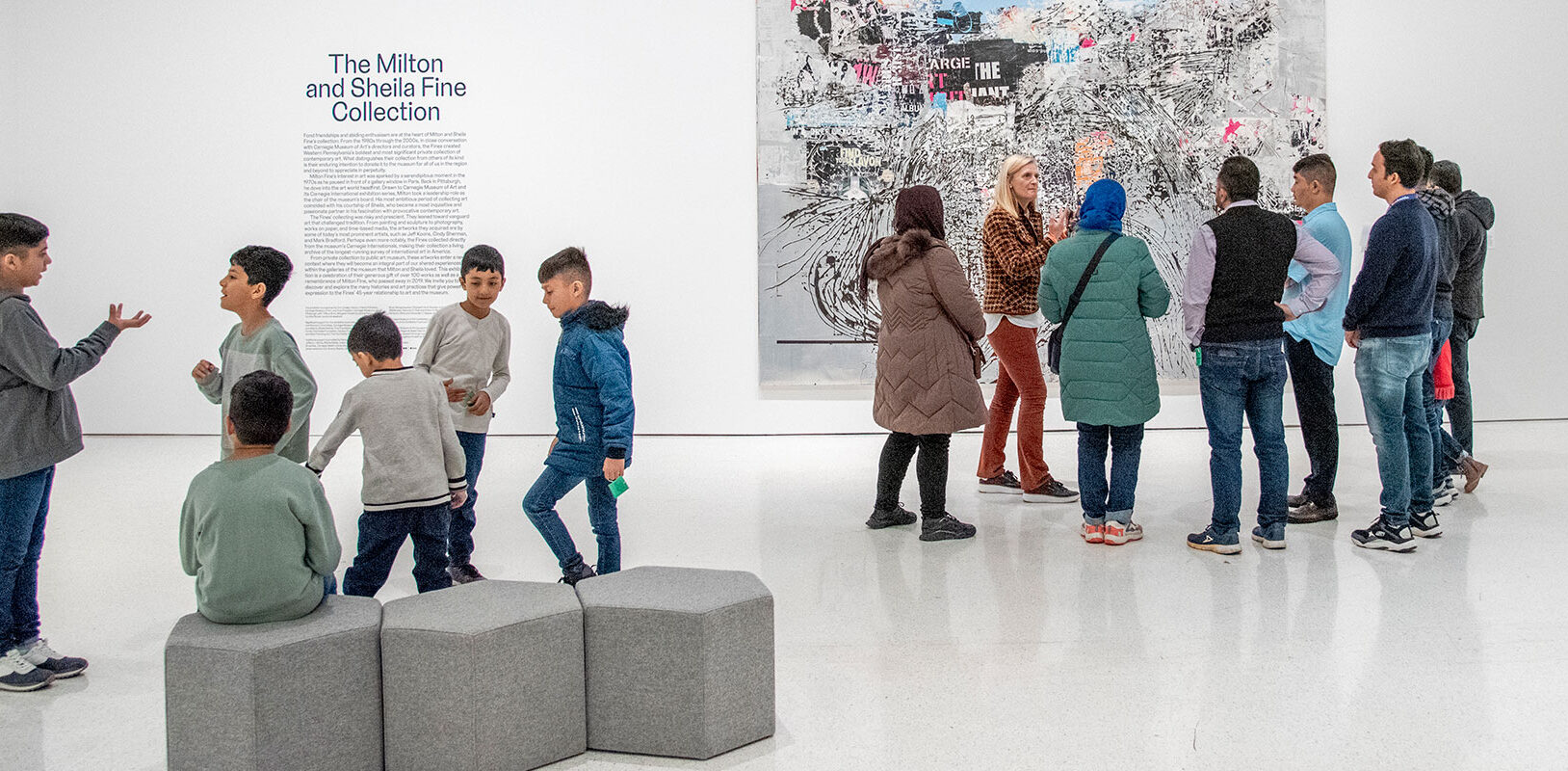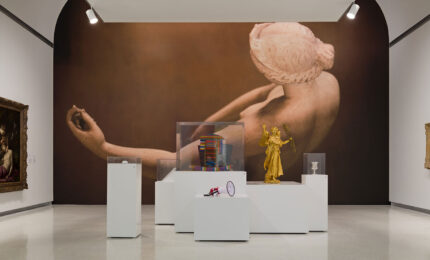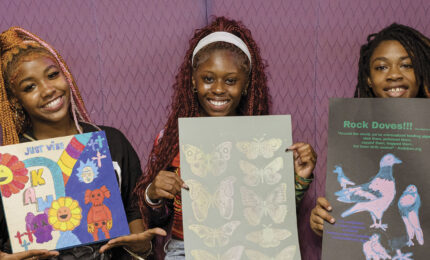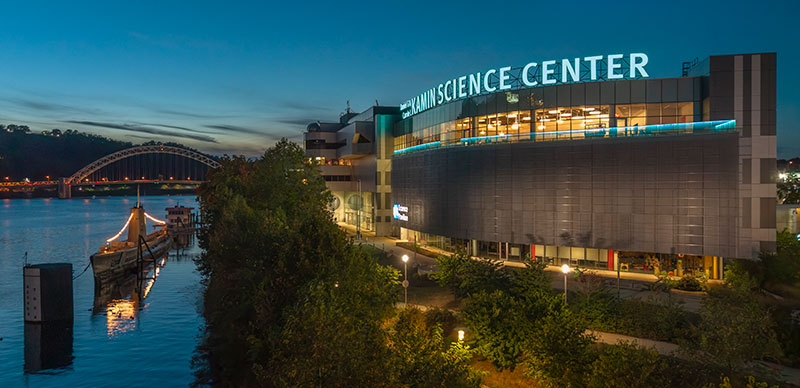On a gray Saturday in early December, a group of Afghan families touring the bright corridors of Carnegie Museum of Art paused in the Heinz Galleries to examine a striking work that drew them in.
The roughly 8-foot-by-12-foot abstract canvas, Noah’s Third Day by the painter Mark Bradford, wasn’t on the itinerary for their prearranged tour. Yet when Eliot Kennedy, the docent leading their tour, noticed the group’s reaction to the work, she felt the need to make space for a conversation.
“One member of the group had such a strong pull and response,” Kennedy says. “After providing some information about the artist having been bullied as a child, and how teachers kept telling him he should be a basketball player because of his height, our visitor connected and understood by looking at how this artist had been through a lot and was showing us small parts of himself.
“It was one of those wonderful moments I treasure—the smile and excitement when talking about this artwork.”
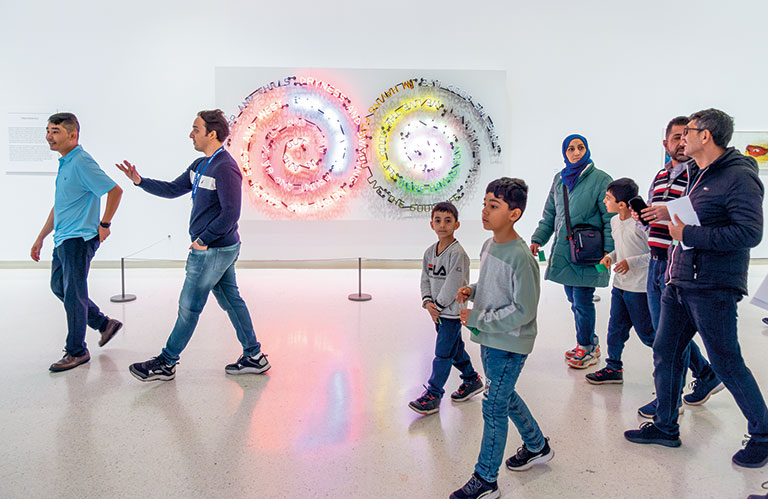 Photo: John Schisler
Photo: John SchislerThe curious guest, Assef Hossaini, was touring with his wife, Zainab, and their two sons (ages 9 and 7). Later Hossaini explained what attracted him to Bradford’s abstract artwork—that its meaning varies drastically for each viewer. “Everyone can interpret this one,” he says. “It’s not very clear. Everybody has their own impression. … Find your flavor.”
The families’ visit to the Museum of Art this particular day wasn’t random; they had been invited as part of the Neighborhood Museum program. Launched in February 2023, it’s designed to introduce the museum as a neighborhood resource for recently arrived refugee families through artwork, artmaking, connection, and community.
Working with eight partner organizations that support refugees in their resettlement process, the museum hosts new families for an orientation in their home language every other Saturday. Families also receive a complimentary annual family membership for up to six people for all four Carnegie Museums, marking what hopefully becomes a long-standing relationship.
“Pittsburgh is a refugee-welcoming city. And as part of Pittsburgh, I think the museum is providing that welcoming environment.”
–Eliot Kennedy, Carnegie Museum of Art Docent
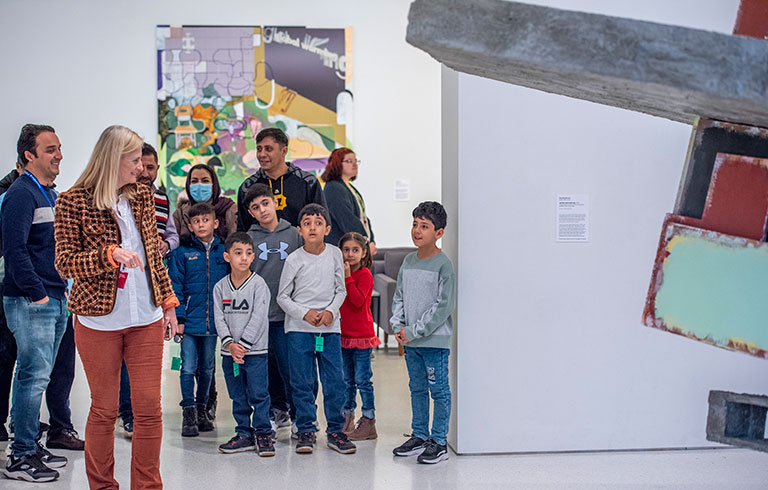 Photo: John Schisler
Photo: John Schisleruntitled: upturnedhouse during a tour of the museum.
During that first visit, a docent and language interpreter accompany families on a dialogue-based tour of the museum and its resources. It offers a lay of the land, the opportunity to view and discuss selected pieces of art, and an artmaking workshop facilitated by museum educators to provide a form of expression for the experiences that each participant brings with them. The rest of the itinerary can fluctuate, based on the interests of that day’s group. Last year, the program gifted memberships to 69 refugee families, totaling more than 400 people who speak at least eight languages.
Kennedy loves how this program offers the families a place to simply relax and be together—“enjoying a break from all the hard decisions and realities they face as refugees and as newcomers to a city.”
“Pittsburgh is a refugee-welcoming city,” Kennedy exclaims. “And as part of Pittsburgh, I think the museum is providing that welcoming environment.”
Connections Beyond Art
Blaine Siegel, Carnegie Museum of Art’s public programs manager, dreamt up the program after a stint as the artist-in-residence at Pittsburgh International Airport five years ago. Late one night, he watched an immigration case worker greet a refugee family who’d just arrived after a long journey. Siegel began asking: What can I do in my world to make this experience better for refugees? This inclusive Carnegie Museums program aims to answer that question while working toward larger goals of being a multicultural institution.
Participating families join through the Museum of Art’s partnership with refugee resettlement and support agencies like Bethany Christian Services, JFCS (Jewish Family and Community Services), AJAPO (Acculturation for Justice, Access, and Peace Outreach), Hello Neighbor, Latino Community Center, Catholic Charities of Pittsburgh, and Casa San Jose.
Many of the families come from conflict regions—Afghanistan, the Democratic Republic of Congo, Ukraine, Colombia, and El Salvador. Interpreters accompany the groups during their visit; in December, two stuck close to help to translate between English, Pashto, and Farsi.
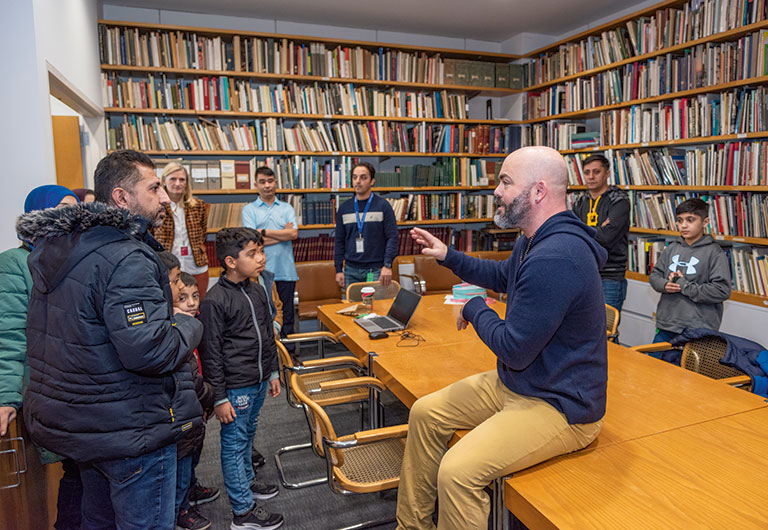 Photo: John Schisler
Photo: John Schisler“We used to say, ‘People need the museum.’ Now we say, ‘The museum needs people,’ and that means all people. You belong in all the museums and everywhere in this city.”
–Blaine Siegel, Carnegie Museum of Art’s public programs manager
As families filed inside for the December visit, possessing varying degrees of English language fluency, Siegel greeted them with friendly banter and a brief overview of the day ahead, helping put everyone at ease. The kids, donning puffy winter coats and sturdy winter boots, wore timid smiles, and one pigtailed participant held her dad’s hand tightly as she tucked herself into his shadow.
Siegel reassured them that they had entered a space that is for each of them. “We used to say, ‘People need the museum,’” he explained, pausing to let the interpreters echo his thoughts in real time. “Now we say, ‘The museum needs people,’ and that means all people. You belong in all the museums and everywhere in this city.”
Siegel then introduced Kennedy, the docent, who spoke in expressive and easily digestible sentences as they began their tour, ascending the Grand Staircase toward the Hall of Sculpture. “I am very happy that you’re here so this can be part of your Pittsburgh,” she tells the families. “Now you can come here to start new memories with your family and friends.”
The start of Kennedy’s tour was as much a history of their newly adopted home as it was an investigation of art. Moving into the room labeled “A Pittsburgh Anthology,” Kennedy touched on the city’s industrial past and how it remains an important memory in the cultural fabric, prompting curious questions about whether steel production continues here to this day.
The group then strolled between works ranging from modern sculpture to Impressionist classics such as Claude Monet’s Water Lilies (Nymphéas) and Waterloo Bridge, London. Kennedy encouraged everyone to share their reactions to the art, especially the younger onlookers.
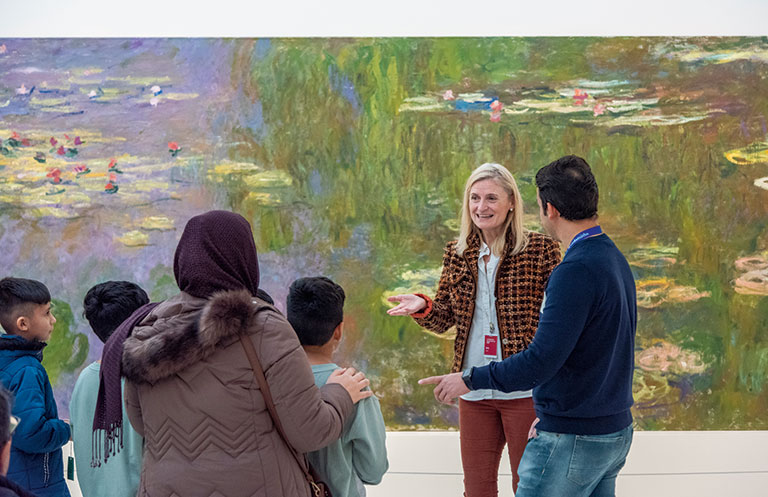 Photo: John Schisler
Photo: John Schisler “When you think of all the hardships and challenges these families are facing,” Kennedy says, “to be able to provide a space where we can look at art and share these deep conversations is an honor. I like the word ‘healing’ in the sense of being able to have a moment of feeling safe and connecting with your environment.”
And as someone who always makes a point to visit museums in a new city, Siegel believes that the Museum of Art can serve as an important community resource and hub. “It helps you understand the local culture,” he says. But perhaps, above all, this program allows families to connect with other refugees and Pittsburgh residents, at what might be a very isolating and disorienting time.
A Sense of Belonging
After the morning tour, several Afghan attendees shared their personal stories—of harrowing escapes from Taliban rule and entire lives left behind. They touched on the heartache of leaving homes and possessions and careers and people they love, carrying only what they could manage on their backs.
“Every Afghan family has a similar story,” notes Yama Azizi, an interpreter with Global Wordsmiths, a Pittsburgh-based language interpreter program that works with Neighborhood Museum. “It’s like this for all.”
Assef Hossaini, the visitor drawn to the Mark Bradford painting, pointed out that his brother was also in attendance with his wife and two sons. Hossaini’s family is from Kabul, and they left home after the Taliban took over in 2021, arriving in Pittsburgh last July. The brothers and their families followed their other brother, Massoud Hossaini, a Pulitzer Prize-winning photographer who’d begun working for the Tribune-Review newspaper. There also seemed to be job opportunities here, Hossaini says, and the resettlement agencies weren’t entirely full, like they are in some other cities.
“I am very happy that you’re here so this can be part of your Pittsburgh. Now you can come here to start new memories with your family and friends.”
–Eliot Kennedy
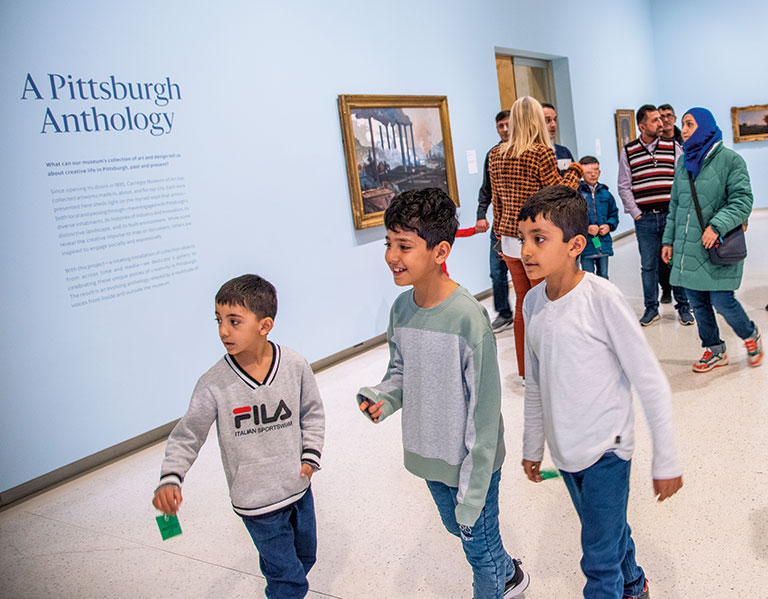 Photo: John Schisler
Photo: John SchislerSince these families bring with them myriad experiences, all program docents and educators are required to participate in a cultural sensitivity training.
Presented by Caley Donovan, the refugee resettlement site supervisor at Bethany Christian Services, the training first details the process refugees go through, from pre-screening and travel to arrival in their new home—with further discussion of the trauma faced by many. Next, Mary Jayne McCullough, director of Global Wordsmiths, offers a “working with an interpreter 101” crash course.
“Everyone is so excited to help, which is wonderful,” Donovan says, “but we want to make sure that they don’t accidentally retraumatize the families they are working with. My training gives them some background, some basic cultural awareness, and some basic tips and strategies to create positive interactions. We also teach them how to work with an interpreter, which is definitely an acquired skill.”
For Hossaini, spending time in a cultural venue like this is a familiar experience.
“I like museums,” Hossaini says, sharing that he used to frequent the art museum in Kabul with his family and orphans he worked with in a former humanitarian role. “It’s a very good benefit for me and my family,” especially during cold winter months.
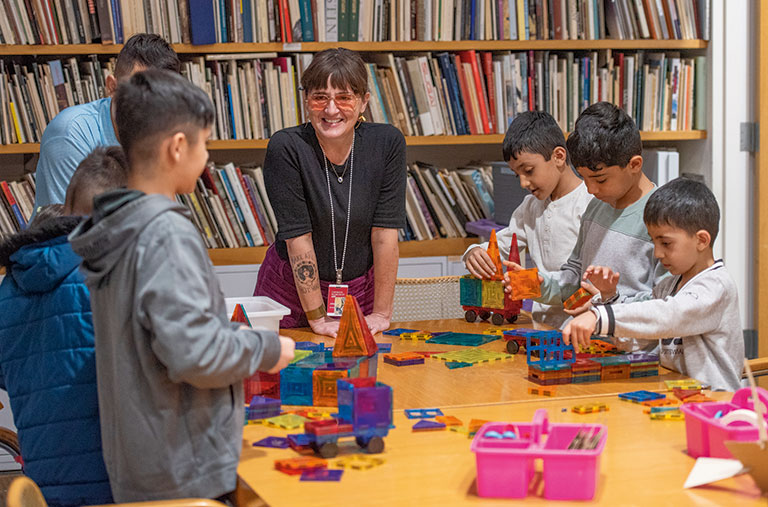 Photo: John Schisler
Photo: John SchislerAssef’s wife, Zainab, thinks this “fresh info” is good for her kids’ minds, and viewing these exhibitions encourages them to talk with one another, too. “It’s really useful for the new generation,” she says. Their family spent the previous weekend at Carnegie Museum of Natural History.
Of the art her family viewed during their facilitated tour, she notes that “some art was very beautiful” and calls out the painting Farallon Island, 1887. She hopes to learn more about its artist, Albert Bierstadt.
Assef and Zainab’s 9-year-old son, Elyas, personally prefers to draw with crayons, but says he still enjoys “the big art.” Elyas’s cousin Yousef (also 9) talked about his favorite work of the morning—untitled: upturned house by Phyllida Barlow, a nearly 12-foot-high boxy sculpture of multicolored panels balanced on stacked shipping pallets. “I think it is so amazing,” Elyas remarks, adding that he also loves the main Oakland building and can’t wait to return.
As for his overall impression of the museum, he says: “I don’t want to go home.”
“I love having that opportunity to personally welcome our groups; it just makes me so happy,” Kennedy exclaims. “And this is a two-way relationship; we benefit hugely as an institution—and personally—by welcoming people of different cultures and perspectives to our museums.”
Donovan adds: “My biggest hope is that these families will come away from Neighborhood Museum with the understanding that they are a part of our Pittsburgh community, and that the museums—and all our city has to offer—are for them too.”
